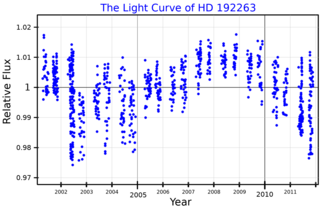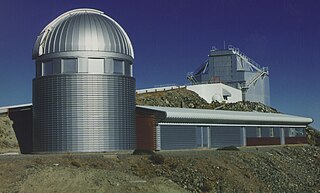HD 82943 is a yellow dwarf star approximately 89 light-years away in the constellation of Hydra. Two extrasolar planets have been confirmed to be orbiting it, and it is thought that the system had more giant planets that were "swallowed" by the parent star. HD 82943 is estimated at 1.15 times the mass of the Sun.
HD 169830 is a star in the southern constellation of Sagittarius. It has a yellow-white hue and is dimly visible to the naked eye with an apparent visual magnitude of +5.90. The star is located at a distance of 120 light years from the Sun based on parallax. It is drifting closer with a radial velocity of −17.3 km/s, and is predicted to come as close as 20.7 ly (6.4 pc) in 2.08 million years. HD 169830 is known to be orbited by two large Jupiter-like exoplanets.
HD 83443 is an orange dwarf star approximately 134 light-years away in the constellation of Vela. As of 2000, at least one extrasolar planet has been confirmed to be orbiting the star. The star HD 83443 is named Kalausi. The name was selected in the NameExoWorlds campaign by Kenya, during the 100th anniversary of the IAU. The word Kalausi means a very strong whirling column of wind in the Dholuo language.
HD 6434 is a star in the southern constellation of Phoenix. Yellow dwarfs such as this are not very luminous, so at a distance of 138 light years it is not visible to the unaided eye. However, with binoculars it is readily visible under ideal observing conditions, having an apparent visual magnitude of 7.71. The star is drifting further from the Sun with a radial velocity of +23 km/s.
HD 216770 is an 8th-magnitude star located approximately 124 light-years away in the constellation of Piscis Austrinus. It is an orange dwarf, and is somewhat dimmer and cooler than the Sun.

HD 192263 is an 8th magnitude star about 64 light years away in the constellation of Aquila. The spectral type of the star is K2V, meaning that it is an orange dwarf, a type of star somewhat cooler and less luminous than the Sun. It is not visible to the unaided eye, but with good binoculars or small telescope it should be easy to spot.
HD 121504 is an 8th magnitude star in the constellation of Centaurus. It is a yellow dwarf and remarkably similar to the Sun, only slightly brighter like α Centauri A. However, it is located at a distance of about 135 light years and thus is not visible to the unaided eye; binoculars or small telescope is required to see this star.
HD 114386 is a 9th magnitude star located approximately 91 light years away in the constellation of Centaurus. It is an orange dwarf, and rather dim compared to the Sun. It can be seen with a telescope or good binoculars.
HD 147513 is a star in the southern constellation of Scorpius. It was first catalogued by Italian astronomer Piazzi in his star catalogue as "XVI 55". With an apparent magnitude of 5.38, according to the Bortle scale it is visible to the naked eye from suburban skies. Based upon stellar parallax measurements by the Hipparcos spacecraft, HD 147513 lies some 42 light years from the Sun.
HD 65216 is a triple star system with two exoplanetary companions in the southern constellation of Carina. With an apparent visual magnitude of 7.97 it cannot be readily seen without technical aid, but with binoculars or telescope it should be visible. The system is located at a distance of 114.7 light-years from the Sun based on parallax measurements, and is drifting further away with a radial velocity of 42.6 km/s.
94 Ceti is a trinary star system approximately 73 light-years away in the constellation Cetus.
HD 142415 is a single star in the southern constellation of Norma, positioned next to the southern constellation border with Triangulum Australe and less than a degree to the west of NGC 6025. With an apparent visual magnitude of 7.33, it is too faint to be visible to the naked eye. The distance to this star is 116 light years from the Sun based on parallax, but it is drifting closer with a radial velocity of −12 km/s. It is a candidate member of the NGC 1901 open cluster of stars.
HD 196050 is a triple star system located in the southern constellation of Pavo. This system has an apparent magnitude of 7.50 and the absolute magnitude is 4.01. It is located at a distance of 165 light-years from the Sun based on parallax, and is drifting further away with a radial velocity of +61 km/s. It is also called by the Hipparcos designation HIP 101806.
HD 6434 b is an extrasolar planet orbiting the star HD 6434. It has a minimum mass about half that of Jupiter. It orbits the star very close, over 2.5 times as close as Mercury orbits the Sun. For this reason it completes one orbit in only 22 days. Unlike true "hot Jupiters" like 51 Pegasi b, HD 6434 b does not have a circular orbit, but rather an eccentric one.
HD 216770 b is an extrasolar planet orbiting the star HD 216770. It has a mass about two thirds that of Jupiter, largest planet in the Solar System. But unlike the gas giants in the Solar System, it orbits in a very eccentric orbit around the star. The mean distance from the star is slightly larger than Mercury's, and it completes one orbit around the star in every 118 days.
HD 111232 b is an extrasolar planet that orbits at almost 2 AU with a minimum mass of 6.8 times that of Jupiter. This planet was discovered in the La Silla Observatory by Michel Mayor using the CORALIE spectrograph on 30 June 2003, along with six other planets, including HD 41004 Ab, HD 65216 b, HD 169830 c, HD 216770 b, HD 10647 b, and HD 142415 b.
HD 169830 b is an extrasolar planet three times the mass of Jupiter. Due to its high mass, it is most likely a gas giant planet, akin to Jupiter and Saturn in the Solar System. This planet at 0.8 AU is slightly farther out than Venus is in the Solar System, orbiting around its star every 262 days.
HD 65216 b is an extrasolar planet located approximately 115 light-years away in the constellation of Carina, orbiting the star HD 65216. This planet was discovered by the Geneva Extrasolar Planet Search Team in 2003. Like most planet candidates so far, it was detected with the radial velocity method.

Leonhard Euler Telescope, or the Swiss EULER Telescope, is a national, fully automatic 1.2-metre (47 in) reflecting telescope, built and operated by the Geneva Observatory. It is located at an altitude of 2,375 m (7,792 ft) at ESO's La Silla Observatory site in the Chilean Norte Chico region, about 460 kilometers north of Santiago de Chile. The telescope, which saw its first light on 12 April 1998, is named after Swiss mathematician Leonhard Paul Euler.
HD 181720 is an 8th-magnitude G-type main sequence star located approximately 190 light-years away in the constellation Sagittarius. This star is larger, hotter, brighter and less massive than the Sun. Also its metal content is three-tenths as much as the Sun.

